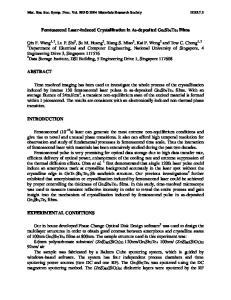Local Electron Beam Induced Reduction and Crystallization in Electrochemically Deposited Amorphous TiO 2 Films
- PDF / 436,182 Bytes
- 9 Pages / 612 x 792 pts (letter) Page_size
- 94 Downloads / 334 Views
0950-D15-18
Local Electron Beam Induced Reduction and Crystallization in Electrochemically Deposited Amorphous TiO2 Films Philippe Kern, and Johann Michler Materials Science Technology, Empa, Feuerwerkerstrasse 39, Thun, 3602, Switzerland
ABSTRACT In this study, we investigated the behaviour of electrochemically deposited amorphous titanium oxide (TiO2) thin films towards controlled electron beam (e-beam) exposure in view of locally modifying its chemical and structural properties. Contrary to crystalline TiO2, we found amorphous TiO2 films to be significantly more sensitive to e-beam irradiation. E-beam exposure experiments were performed under scanning electron microscope conditions at 20 keV with well-controlled beam current (IP), current density and exposure dose. As shown by atomic force microscopy and Micro-Raman spectroscopy, even moderate e-beam exposure immediately leads to oxide reduction and local film volume loss due to electron stimulated oxygen desorption, while exposure with IP≥1 µA and J≥1 A/cm2 triggers localized crystallization into anatase phase already after seconds of irradiation. The mechanisms for oxide reduction and beam heating induced crystallization are discussed, and an estimation of the temperature in the beam center indicates that crystallization occurs at less than 150 °C. The well-defined volume loss upon oxygen desorption is shown to be attractive for precise topographical surface patterning in combination with e-beam lithography tools, while triggering of local structural changes within a semi-conductive amorphous matrix opens interesting possibilities for tailoring of its local electrical or catalytic properties.
INTRODUCTION Local modifications in crystalline TiO2 films or powders have been achieved by ion implantation, laser as well as electron beam (e-beam) irradiation, while local changes in amorphous TiO2 have not been reported today. Even so a-TiO2 can be obtained by plasma enhanced chemical vapour deposition [1,2] or magnetron sputtering [3], crystalline films are mostly aimed at due to slightly better dielectric constants [2], and probably also because TiO2 in the crystalline state is better investigated than in amorphous state. Low density (µAcm-2) ebeams below 1 kV in an Auger microscope [4] have been shown to induce an energy and dose dependent controlled number of Ti3+ defects in TiO2 (110). Lower oxidation states than Ti3+ were not observed. Taking use of the high probe current densities and accelerating voltages of transmission electron microscopes (TEM), several authors investigated the effect of e-beam irradiation on the oxidation state of crystalline TiO2. Mc Cartney et al. [5,6] observed formation of epitaxial TiO at current densities between 5-50 Acm-2 and reduction beyond the monoxide after irradiation at extremely high current densities (103-104 Acm-2) at 100-400 kV of rutile single crystal samples. Irradiation resulted in extensive pitting in the observed zone. Contrary, TiO2 anatase powder did not show any noticeable structural or electronic changes upon T
Data Loading...








